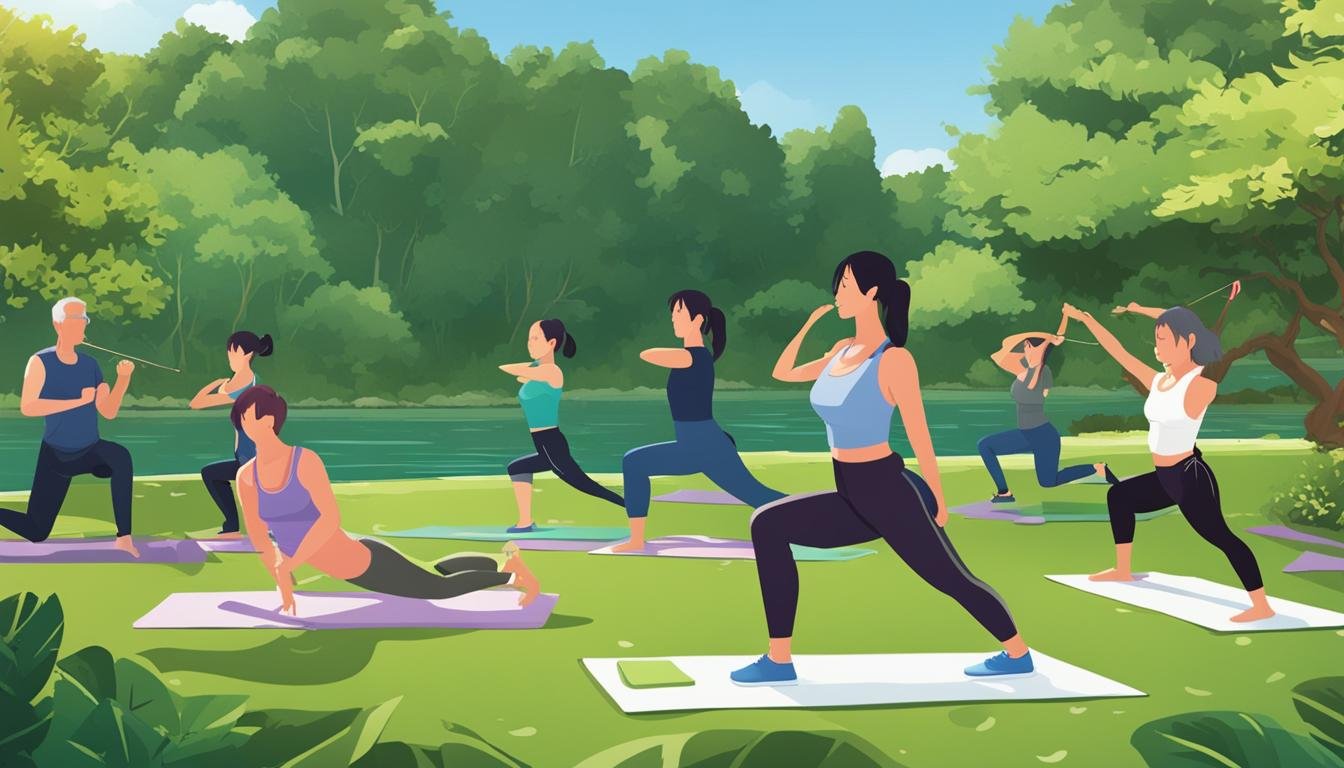As we age, it becomes increasingly important to prioritize joint health. For adults over 40, maintaining strong and flexible joints can help prevent pain, reduce the risk of injuries, and ensure a high quality of life. If you’re looking for gentle exercises that are easy on the joints, we’ve got you covered. In this article, we’ll explore low-impact workout options that are specifically designed for adults over 40 with joint issues. Whether you’re new to exercise or have been active for years, these joint-friendly routines can help you stay fit and healthy.
Key Takeaways:
- Low-impact exercises are ideal for adults over 40 with joint issues.
- Walking, swimming, and cycling are excellent low-impact workout options.
- Resistance training, yoga, and tai chi can help strengthen joints and improve flexibility.
- Choosing the right type of exercise is crucial for maintaining joint health.
- Consult with a healthcare professional before starting any new exercise routine.
Understanding Your Joints and Risk Factors
Joints play a crucial role in our body, connecting two bones together and allowing us to move freely. However, as we age, our joints can become vulnerable to various problems that can cause pain, inflammation, and limited mobility. It is important to understand the factors that can contribute to joint issues in order to effectively prevent and manage them.
There are several risk factors that can increase the likelihood of developing joint problems. These include age-related wear and tear, previous joint injuries, hormonal changes, poor dietary habits, lack of exercise, and obesity. Women over 40 are particularly susceptible to joint problems due to hormonal changes associated with menopause and the natural aging process.
To maintain joint health and prevent joint issues, it is important to adopt a holistic approach that encompasses regular exercise, a healthy diet, and proper care. Regular exercise, including low-impact activities like walking, swimming, and cycling, can help strengthen the muscles around the joints and improve joint function. A nutritious diet rich in anti-inflammatory foods such as fruits, vegetables, lean proteins, and whole grains can help reduce joint inflammation and support joint health.
“Regular exercise, including low-impact activities like walking, swimming, and cycling, can help strengthen the muscles around the joints and improve joint function.”
In addition to exercise and nutrition, it is essential to seek proper diagnosis and treatment for any existing joint issues. Consulting with a healthcare professional can help determine the underlying cause of joint problems and guide the appropriate treatment plan. This may include medications, injections, physical therapy, or other interventions that can provide relief and improve joint health.
| Risk Factors for Joint Problems | Preventive Measures |
|---|---|
| Age-related wear and tear | Regular low-impact exercises |
| Hormonal changes | Healthy diet with anti-inflammatory foods |
| Poor dietary habits | Proper diagnosis and treatment |
| Lack of exercise | Weight management |
| Obesity | Consultation with healthcare professional |
Frequently Asked Questions
- What are the risk factors for joint problems?
- How can exercise and nutrition help maintain joint health?
- What is the importance of seeking proper diagnosis and treatment for joint issues?
- What are some low-impact exercises that can benefit joint health?
Choosing the Right Type of Exercise
When it comes to maintaining joint health for women over 40, choosing the right type of exercise is crucial. Opting for joint-friendly and low-impact exercises can help strengthen the joints without putting excessive stress on them. Here are some examples of exercises that are easy on the joints:
- Walking: Walking is a simple and effective exercise that can be easily incorporated into your daily routine. It is low-impact and helps improve cardiovascular health while putting minimal stress on the joints.
- Swimming: Swimming is a great option for women over 40 with joint issues. The buoyancy of the water reduces the impact on the joints while providing a full-body workout.
- Cycling: Cycling, whether outdoors or on a stationary bike, is a low-impact exercise that strengthens the legs and improves cardiovascular fitness without straining the joints.
- Rowing: Rowing is a whole-body workout that engages multiple muscle groups while being gentle on the joints. It can be done on a rowing machine or by participating in outdoor rowing activities.
- Elliptical workouts: Using an elliptical machine provides a low-impact and joint-friendly cardiovascular workout that mimics the motion of walking or running without the impact on the joints.
- Resistance-training exercises: Incorporating resistance training with lighter weights or bodyweight exercises can help strengthen the muscles around the joints, providing stability and support.
- Yoga and tai chi: These mind-body exercises focus on gentle movements, stretching, and improving balance and flexibility, which can be beneficial for joint health.
On the other hand, it is important to avoid high-impact activities like running and jumping if you have weak or painful joints. These activities can put excessive stress on the joints and may worsen joint pain or cause injury. It is essential to listen to your body and choose exercises that do not cause pain or discomfort.
Remember to consult with your healthcare provider or a fitness professional before starting any new exercise regimen, especially if you have existing joint issues. They can provide personalized recommendations and guide you in choosing the right exercises for your specific needs and abilities.
| Exercise | Type | Benefits |
|---|---|---|
| Walking | Low-impact | Improves cardiovascular health; strengthens legs |
| Swimming | Low-impact | Full-body workout; reduces stress on joints |
| Cycling | Low-impact | Strengthens legs; improves cardiovascular fitness |
| Rowing | Low-impact | Whole-body workout; engages multiple muscle groups |
| Elliptical workouts | Low-impact | Cardiovascular workout without joint impact |
| Resistance-training exercises | Low-impact | Strengthens muscles around joints; provides stability |
| Yoga and tai chi | Low-impact | Improves flexibility, balance, and relaxation |
Eating a Healthy Diet for Joint Health
When it comes to maintaining joint health, nutrition plays a critical role. Choosing the right foods can help reduce joint inflammation, strengthen the joints, and support overall joint health. Incorporating a variety of anti-inflammatory foods into your diet is essential for women over 40 to promote joint health and prevent joint issues. Here are some key dietary tips to keep in mind:
Include Plenty of Fruits and Vegetables
Fruits and vegetables are rich in vitamins, minerals, and antioxidants that help reduce inflammation and support joint health. Opt for colorful options like berries, citrus fruits, leafy greens, and cruciferous vegetables such as broccoli and cauliflower. These foods provide essential nutrients that promote joint health and overall well-being.
Choose Lean Proteins and Healthy Fats
Include lean proteins like poultry, fish, tofu, and beans in your diet. These foods provide essential amino acids that support muscle and joint health. Additionally, incorporate healthy fats such as avocados, nuts, seeds, and olive oil. These fats help reduce inflammation and provide lubrication for the joints.
Opt for Whole Grains
Whole grains like quinoa, brown rice, and whole wheat bread are rich in fiber and provide important nutrients for joint health. They also help regulate blood sugar levels and promote overall health. Incorporating whole grains into your diet can help reduce inflammation and support joint function.
Incorporating these dietary tips into your daily routine can greatly contribute to joint health for women over 40. By nourishing your body with anti-inflammatory foods, you can support your joints and reduce the risk of joint problems.
| Anti-Inflammatory Foods for Joint Health | Examples |
|---|---|
| Fruits | Berries, citrus fruits, apples, grapes |
| Vegetables | Leafy greens, broccoli, cauliflower, bell peppers |
| Lean Proteins | Poultry, fish, tofu, beans |
| Healthy Fats | Avocados, nuts, seeds, olive oil |
| Whole Grains | Quinoa, brown rice, whole wheat bread |
Considering Physical Therapy and Alternative Therapies
Physical therapy plays a crucial role in enhancing joint health for women over 40. By working with a qualified physical therapist who specializes in inflammatory conditions, you can develop a customized treatment plan tailored to your specific needs. This may include stretches, exercises, and recommendations for joint health. Physical therapy can help improve joint mobility, reduce pain and inflammation, and enhance overall functionality.
In addition to physical therapy, alternative therapies such as acupuncture and massage can provide relief from joint pain and discomfort. Acupuncture involves the insertion of thin needles into specific points on the body to stimulate natural healing and promote pain relief. Massage therapy, on the other hand, involves the manipulation of soft tissues to improve blood flow, reduce muscle tension, and alleviate joint stiffness. These therapies can be used in conjunction with other treatments to optimize joint health.
Another emerging field in joint health is regenerative medicine. This approach involves using techniques such as stem cell treatment or platelet-rich plasma (PRP) injections to stimulate the body’s natural healing process and promote tissue regeneration. While regenerative medicine is still being researched and refined, it shows promising results in improving joint health and reducing pain. Consult with your healthcare provider to determine if regenerative medicine is a suitable option for you.
Table: Overview of Physical Therapy and Alternative Therapies for Joint Health
| Treatment | Description |
|---|---|
| Physical Therapy | Customized treatment plan with stretches, exercises, and recommendations for joint health. |
| Acupuncture | Insertion of thin needles into specific points on the body to stimulate natural healing and pain relief. |
| Massage Therapy | Manipulation of soft tissues to improve blood flow, reduce muscle tension, and alleviate joint stiffness. |
| Regenerative Medicine | Techniques such as stem cell treatment or PRP injections to stimulate natural healing and tissue regeneration. |
Taking Joint Health-Enhancing Supplements
As we age, maintaining joint health becomes increasingly important. In addition to exercise and a healthy diet, taking joint health-enhancing supplements can provide additional support for women over 40. Joint RX supplements offered by the Fit Mother Project are specifically formulated to reduce joint pain and improve joint health. These supplements contain a combination of vitamins, minerals, herbs, and other ingredients that work synergistically to promote joint health and reduce the risk of chronic diseases.
Joint RX supplements are packed with essential nutrients such as vitamins D, K, B6, B12, calcium, magnesium, and zinc, which are crucial for maintaining strong and healthy joints. They also contain innovative joint-enhancing ingredients like UC-2 collagen, turmeric extract, boswellia serrata extract, hyaluronic acid, pine bark extract, boron, and black pepper extract. These ingredients have been carefully selected for their anti-inflammatory properties and ability to support joint function.
By incorporating Joint RX supplements into your daily routine, you can provide your joints with the necessary nutrients they need to stay healthy and pain-free. These supplements are designed to complement your efforts in exercise and a balanced diet, giving you a comprehensive approach to joint health. Remember to consult with your healthcare provider before starting any new supplement regimen to ensure it aligns with your specific needs and medical history.
| Key Benefits of Joint RX Supplements: |
|---|
| Reduces Joint Pain: The combination of anti-inflammatory ingredients helps alleviate joint discomfort and pain. |
| Improves Joint Function: Essential nutrients and joint-enhancing ingredients support joint mobility and flexibility. |
| Supports Joint Health: Vitamins and minerals promote overall joint health and reduce the risk of chronic diseases. |
| Enhances Recovery: Joint RX supplements aid in the recovery process after exercise, reducing exercise-induced joint inflammation. |
| Promotes Optimal Joint Health: The comprehensive formula of Joint RX supplements provides a holistic approach to joint care. |
Remember, taking joint health-enhancing supplements should be part of a broader joint care routine that includes regular exercise, a healthy diet, and lifestyle modifications. By taking a proactive approach to your joint health, you can ensure that you remain active, pain-free, and mobile well into your 40s and beyond.
Incorporating Exercise into Daily Routine
As adults over 40, it is important for us to prioritize exercise and incorporate it into our daily routine to maintain joint health. Regular physical activity has numerous benefits for our overall well-being, including strengthening our joints, improving flexibility, and reducing the risk of chronic diseases. To make exercise a regular part of our lives, here are some key considerations:
Exercise Frequency
We should aim for at least 150 minutes of moderate-intensity aerobic activity or 75 minutes of vigorous-intensity aerobic activity each week, spread over several days. This translates to about 30 minutes of exercise on most days of the week. By setting aside dedicated time for exercise, we can ensure that we are meeting the recommended guidelines for maintaining joint health and overall fitness.
Exercise Routine for Adults over 40
Our exercise routine should be well-rounded, combining cardiovascular exercises, strength training, and balance exercises. Cardiovascular exercises, such as brisk walking, biking, swimming, or using the elliptical machine, help improve heart health and increase endurance. Strength training exercises, using lighter weights or bodyweight, can help maintain muscle mass and strengthen our joints. Balance exercises, such as standing on one leg or practicing yoga, can improve stability and prevent falls, which can be particularly beneficial for joint health.
Sample Exercise Routine:
| Day of the Week | Exercise | Duration |
|---|---|---|
| Monday | Brisk Walking | 30 minutes |
| Tuesday | Strength Training (Bodyweight exercises) | 20 minutes |
| Wednesday | Yoga | 30 minutes |
| Thursday | Swimming | 30 minutes |
| Friday | Strength Training (Light weights) | 20 minutes |
| Saturday | Rest Day | – |
| Sunday | Balance Exercises | 15 minutes |
Remember, this is just a sample routine. Feel free to modify it according to your preferences, fitness level, and any specific recommendations from your healthcare professional or personal trainer.
By incorporating exercise into our daily routine and maintaining a consistent schedule, we can prioritize our joint health and overall well-being. It’s important to listen to our bodies, start slowly, and gradually increase the intensity and duration of our workouts. With dedication and commitment, we can reap the benefits of exercise and enjoy a healthier, more active lifestyle.
Staying Consistent and Motivated
Consistency is key when it comes to maintaining joint health for women over 40. It’s important to make exercise a regular part of your routine and stay motivated along the way. By staying consistent with your workouts, you can ensure that you’re giving your joints the attention they need and reaping the benefits of improved joint health.
One great way to stay motivated is to join group exercise classes. Not only do these classes provide structure and guidance, but they also offer a sense of community and camaraderie. Exercising with others can be a fun and social experience, making it easier to stick to your fitness routine. Plus, having a supportive group around you can provide additional motivation and accountability.
Creating an accountability system can also help you stay on track. Find a workout buddy or partner who shares your goals and holds you accountable for sticking to your exercise plan. You can set goals together, track your progress, and support each other along the way. Having someone to answer to can prevent you from slacking off and keep you motivated to continue prioritizing your joint health.
In addition to group classes and accountability partners, having a support system in place is crucial. Surround yourself with friends and family who understand and support your fitness journey. They can provide encouragement, celebrate your achievements, and help you overcome any obstacles that may arise. Having a strong support system can make a big difference in staying consistent and motivated throughout your exercise routine.
| Consistency Tips | Motivation Strategies |
|---|---|
|
|
Conclusion
In conclusion, maintaining joint health is crucial for adults over 40, particularly women who are more susceptible to joint problems. By incorporating exercises that are easy on the joints, such as low-impact activities like walking, swimming, and cycling, into your regular routine, you can strengthen your joints and reduce the risk of pain and debilitating injuries. Additionally, focusing on a nutritious diet, considering physical therapy and alternative therapies, taking joint health-enhancing supplements, and staying consistent with exercise all contribute to enhancing joint health in women over 40.
By making these lifestyle changes and prioritizing joint health, you can enjoy an active and fulfilling life while minimizing the risk of joint issues. So, whether it’s choosing low-impact exercises, consuming a healthy diet, or seeking out alternative therapies, taking proactive steps to maintain and enhance your joint health is crucial for your overall well-being as you age. Remember, it’s never too late to prioritize your joint health and take control of your physical fitness.
So, let’s make a commitment today to prioritize our joint health and incorporate exercises that are kind to our joints into our daily lives. Let’s take care of our bodies, strengthen our joints, and enjoy the benefits of a healthy, active lifestyle well into our 40s and beyond. Together, we can maintain and enhance our joint health and continue living our lives to the fullest.
FAQ
What are some easy exercises for adults over 40 that are gentle on the joints?
Some low-impact exercises that are easy on the joints for adults over 40 include walking, swimming, cycling, rowing, elliptical workouts, and resistance training with lighter weights or bodyweight exercises. Yoga and tai chi are also beneficial for joint health.
What are the risk factors for joint problems and how can they be diagnosed and treated?
Risk factors for joint problems include age-related wear and tear, diseases, and injuries. Joint problems can be diagnosed and treated through proper diagnosis from a healthcare professional, who might prescribe medications, injections, physical therapy, or other treatment options based on the specific joint issue.
How can I choose the right type of exercise for joint health?
Choosing low-impact exercises like walking, swimming, cycling, rowing, elliptical workouts, and resistance training can help strengthen joints without putting excessive stress on them. It’s important to avoid high-impact activities like running and jumping if you have weak or painful joints.
What should I eat to support joint health?
Consuming a balanced diet rich in anti-inflammatory foods is important for joint health. Include fruits, vegetables, lean proteins, whole grains, and healthy fats in your diet. Opt for non-starchy vegetables, protein foods, and fiber-rich starches for each meal. Stay hydrated by drinking plenty of water.
Are there alternative therapies that can support joint health?
Yes, alternative therapies like acupuncture and massage can provide relief from joint pain, improve blood flow, and reduce discomfort. Regenerative medicine, such as stem cell treatment or platelet-rich plasma (PRP) injections, can also stimulate natural healing and promote joint health.
Can joint health-enhancing supplements help with joint issues?
Yes, joint health-enhancing supplements can support joint health for women over 40. Joint RX supplements from the Fit Mother Project contain a combination of vitamins, minerals, herbs, and other ingredients that help reduce joint pain and improve joint health.
What exercises should I incorporate into my daily routine for joint health?
Aim for at least 30 minutes of moderately strenuous activity each day, such as walking, biking, swimming, or using the elliptical machine. Strength training exercises using lighter weights or bodyweight can help maintain muscle mass and joint strength. Balance exercises can improve stability and prevent falls.
How can I stay consistent and motivated with my joint health routine?
Finding enjoyable and sustainable ways to exercise is key. Consider joining group exercise classes or finding an accountability partner to keep you on track. Having a support system can provide motivation and encouragement to stick with your exercise routine. Remember to listen to your body and prioritize rest and recovery.
What can I do to maintain and enhance joint health as a woman over 40?
By incorporating joint-friendly exercises, maintaining a healthy diet, considering physical therapy and alternative therapies, taking joint health-enhancing supplements, and staying consistent with exercise, women over 40 can maintain and enhance their joint health, reducing the risk of joint issues.






